Agricultural policy mishaps
Trade is becoming important for Indian agriculture. Exports have been rising fast in the Nineties as our agriculture diversifies itself w...

Trade is becoming important for Indian agriculture. Exports have been rising fast in the Nineties as our agriculture diversifies itself with commercial crops growing roughly double the rate of foodgrains and fish, poultry and dairying, growing at around seven percent annual. Last two years the agricultural trade went down, since around two fifth of our exports were to the Asian and East Asian countries and their economic levels fell and so also the demand for imported food’. But this is temporary and trade will now rise rapidly.
India has also under the present government abolished quantitative controls on agricultural imports. This year’s import policy has given major concessions on agricultural imports. India’s agricultural trade will, therefore, go up in a big way. It is likely that an assessment I had made in a major UN study on agricultural trade in the ESCAP region after the GATT agreement, that India’s trade will rise by around ten percent annual, will now become a reality. It is important that wenurture this process. Trade will be a small part of our total agricultural demand, but it can have technological impacts.
The question is how do we design our trade policy and reform. We are going in for major negotiations and preparation is important. Unfortunately, in the past we signed major treaties without adequate participation of all the stakeholders and, more important, a public understanding of issues. Most civilised countries have a broad-based process of discussion and consultation before they enter into a major process of negotiation. The reform process is buttressed, as it were in public debates and the widespread political process. In other countries, this discussion is started well in time, is detailed and involves all the stakeholders. To give a recent example, Ambassador Charlene Barshefsky, the US Trade Representative, while giving testimony to the Senate Committee on Agriculture on May 17, went into great details on the US view on agricultural policies in other countries. It is extremelylikely that the US would appreciate discussion with a well informed India even if there are disagreements. She pointed out how they had won on 18 out of 19 complaints to the WTO against EU, Korea, Hungary, Philippines and so on. She pointed out "consultations with domestic interests" was an important part of negotiations in the WTO ahead. In India 115 million new members of the middle class will be "a booming potential market for our products". The US will aim at "further discipline on subsidies".
Why are the issues of subsidies important? International trade negotiations put a cap on subsidies of the government directly to agriculture and also through economic policies in what is called the aggregate measure of support’ (AMS) to agriculture. The AMS is calculated by working out agricultural output and input process at international and domestic prices. If this difference between the two is positive, the AMS is negative. In other words, the argument is that if restrictions to trade are removed, the farmerwould benefit. If the AMS is negative, the country is "taxing" agriculture. India should in this view stop price support and subsidy programmes and allow free trade of goods and inputs. The farmer would get higher prices for sale of goods and buy inputs at cheaper prices. With this approach a critique of Indian agricultural policy was that the impact of its economic and trade policy was the negative AMS. In other words, Indian economic policies led to an implicit tax on agriculture.
This view was very popular abroad, but some Indian economists also supported it. These calculations were done outside India in the Eighties and were repeated within the country. It was also argued that wheat was taxed, but oilseeds were supported. Since I had chaired both the Agricultural Prices Commission and the Bureau of Industrial Costs and had some understanding of the way the numbers were worked out, I argued that these studies were interesting, but world prices of agricultural goods varied in cycles. Wheat prices couldrange between US $ 150 and 250. Similarly, prices of inputs like fertiliser and diesel would vary. Anyway price support programmes were for individual crops and were operative in some crops, in some regions and at only some time of the year when they fell below support prices.
But some Indian economists supported the argument that Indian support and subsidy policies had an anti-agriculture bias and needed to be given up and in the early Nineties, these views were strongly advocated by the economic policy makers of the period. Critiques of the negative AMS argument included the present chairman of the Agricultural Prices Commission, who argued that since terms of trade have moved in favour of agriculture in India and against it in the rest of the world, the negative AMS would be incongruous. One of his predecessors showed that costs of production of oilseeds in India were below import prices and so the argument of subsidising oilseeds was wrong. However, no notice was taken of these criticisms and oureconomic ministries kept on repeating the negative AMS argument to defend their policies of negotiating the opening up of the Indian agricultural economy.
It is now being said that the AMS in India is positive. This is from the same sources which earlier took the opposite position and was announced in a recent seminar in Delhi and elsewhere. This has profound implications for India and is not understood by its negotiators. More on this next time.



- 0116 hours ago
- 0215 hours ago
- 0312 hours ago
- 0416 hours ago
- 0516 hours ago




























